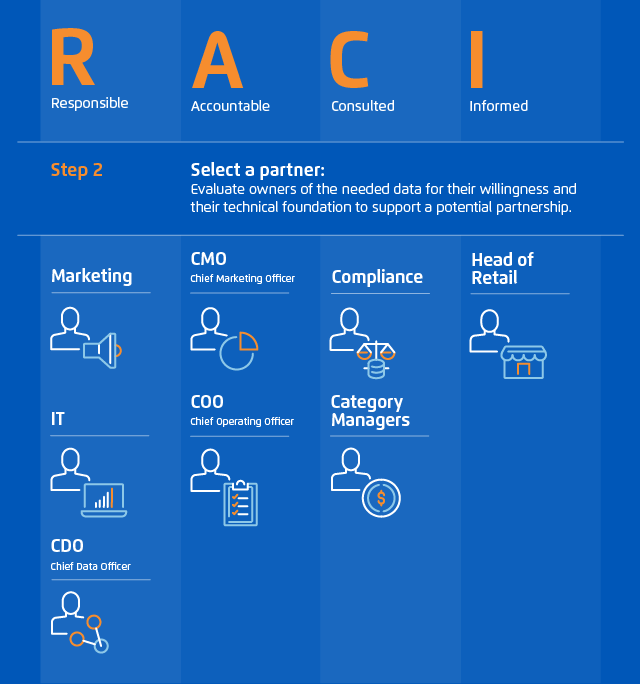Data collaboration is hot. As brands seek to extract more value out of their first-party data and fill in the gaps left by the demise of the third-party cookie, they’re turning to mutually beneficial partnerships to generate high-value insights.
But successful data collaboration depends on a lot of human collaboration behind the scenes. To get there, you need to align around the agendas, controls, and technologies that make data sharing safe and secure.
So how do you chart a path forward and bring various stakeholders along?
A model for data collaboration success
A recent Winterberry report includes a handy RACI model that breaks down who needs to do what for a typical data partnership around media activation and measurement. The people you go to will vary depending on your organization and use case, so consider the report and infographic below less of a template and more of a thought-starter for the conversations you can be having at each step.
Here’s what the RACI looked like when Danone, a global leader in food and beverages, collaborated with a prominent retailer through LiveRamp.
Step 1: Identify the business case
Danone needed to strengthen consumer intelligence to sharpen its media strategy and boost ROI. The pandemic of 2020 brought not only business disruption but also new media consumption habits. These shifts impacted Danone’s product development and consumer messaging, so it was vital to gather insights and act as quickly as possible.
With these strategic objectives in mind, Danone zeroed in on two objectives:
- Understanding the impact of Danone’s digital advertising on audience segments and their path to purchase at the retailer.
- Optimizing omnichannel activations based on transactional data.
The RACI framework for conversations in this stage looked like this:

Step 2: Find the right partner
Unlike retailers with brick-and-mortar and e-commerce storefronts, Danone did not have data to reach large volumes of consumers directly, so forming accurate audience segments tied to key buyer personas was another hurdle. The solution? Partnering with prominent retailers who have the data sets Danone needed to run more efficient, effective media campaigns. The RACI:

Step 3: Set the rules
The partnerships progressed quickly due to the data security embedded in Safe Haven, with all retail data pseudonymized and free of directly identifying information (DII). Additional reviews ensured that no (DII) could be added into the environment and no data could be exported—data was always managed and under control.
Data quality and sourcing (or provenance—where the data is from and how it is gathered) were also key points at this stage, as analytics teams assessed quality and the expected accuracy of the insights they wanted to uncover. Some data would have to be handled within certain constraints due to permission limitations imposed by the partners, and governance agreements control how the data would be used within the Safe Haven environment and how the results would be applied to inform Danone’s business.
LiveRamp hosted sessions between the partner IT organizations, including data/analytic teams as well as legal officers, so they understood the core functionality and environment controls to keep data safe and secure.

[To dive deeper into provenance, governance, and permission, check out our previous blog.]
Step 4: Put it in action
Danone tapped the data marketing experts at Numberly who activated audience segments built with permissioned data from Danone and its retail partners right from Safe Haven. This enabled consistency across channels, laying the groundwork for its larger goals of moving to post-cookie advertising and owning its data future.
It’s all about people
Data collaboration isn’t just a technology issue—it’s a people issue. For Danone, bringing stakeholders together across the data collaboration lifecycle helped teams overcome the extraordinary challenges they encountered along the way. These internal and external partnerships will serve them well as they look beyond their four walls to achieve deeper customer understanding.
Where to go next
Check out the Winterberry Report: Collaborative Data Solutions for a deeper dive into how brands can accelerate data collaboration initiatives.
If you’re ready to start filling in a RACI model for a data collaboration pilot, we can connect you with one of our data strategists who can help!
